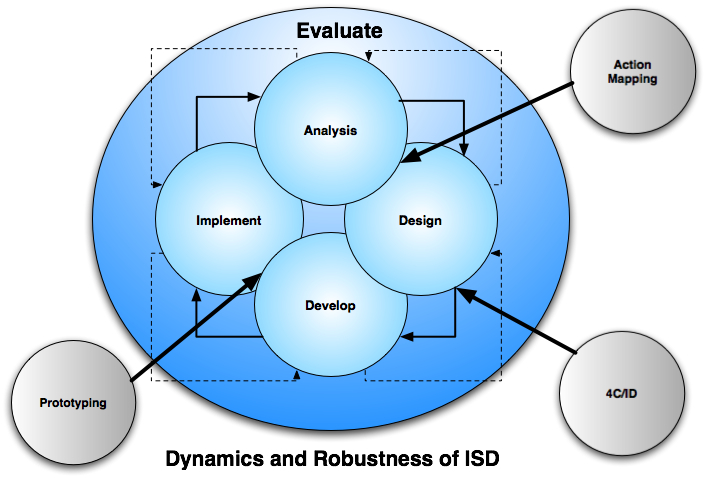One of the trends in the learning industry is proclaiming that a new Instructional Design (ID) model, such as rapid development prototyping, needs to replace Instructional System Design (ISD) because the new model provides more benefits, such as it's newer, dynamic, and faster. Yet ID models differ from ISD models, thus its sort of like saying that a new boat model is going to replace the automobile—yes they are both transportation devices but they do differ in their uses!
ID (Instruction Design) models differ from ISD models in that ISD models have a broad scope and typically divide the instruction design process into five phases (van Merriënboer, 1997):
- Analysis
- Design (sometimes combined with Development)
- Development
- Implementation or Delivery
- Evaluation
Since ISD models cover a broad spectrum they normally do not go into much detail in the design phase. This is where ID models excel. Since they are less broad in nature and mostly focus on design, they normally go into much more detail for the design phase.
Two popular ISD models are ADDIE and The Dick and Carey Model. ISD can also be extended by using Frog Design's model to solve wicked or complex problems as it aligns with ADDIE:
Some popular ID models include Rapid Instructional Design (RID), Gagne's Nine Steps of Instruction, John Keller's ARCS model, Merrill's Component Display Theory, and van Merriënboer's 4C/ID Model.
ISD can be thought more of as a project management tool while ID models are specialized tools used to enhance the learning process.
Omitting ISD and relying strictly on an ID model often omits critical parts of the design process, such as analysis and evaluation. Thus, unless you design for certain groups in an organization or industry in which you know your learners, analysis is important to determine the skill level that the learning program is aimed at. In addition, managers will often identify any performance problem as a training problem, thus the designer needs to ensure it is indeed a training problem rather than a bad process or motivation problem.
Evaluation is not only important to determine if the program is meeting the needs of the organization, but also as a learning tool for the designers themselves.
The best way to use ID models is to plug them into the ISD model as they are needed. For example:

This method allows you to gain the benefit of the ID model that will best suit your needs for enhancing your learning program, while ensuring that your learning program will do what it is supposed to do.
Reference
van Merriënboer, J. J. G. (1997). Training Complex Cognitive Skills: A Four-Component Instructional Design Model for Technical Training. Englewood Cliffs, New Jersey: Educational Technology Publications.
3 comments:
Good analysis, but current development time frames seem to require a tweak to the standard ADDIE ISD model. To wit: on my last two projects I had to, in effect, design and develop simultaneously.
The other issue that seems vital to me is that if evaluation is simply taking a quiz at the end of a module, then its simply "pro forma".
I prefer performance based evaluations based on realistic scenarios in order to have confidence that the training meets its objectives
Actually, ISD is not linear in that at least since 1975 the ADDIE ISD model has been noted as being quite dynamic. This is from an U.S. Army manual, "The five phases of ISD are analysis, design, development, implementation, and evaluation and control. The first four are sequential in nature, but the evaluation and control phase is a continuous process that is conducted in conjunction with all of the others."
So while the military has been using the ADDIE as a dynamic model, a lot of the civilian organizations still picture it as being linear. See the History of ADDIE at: http://nwlink.com/~donclark/history_isd/addie.html
I agree with you about performance based solutions. A performance test during class tells you that the learners know how to perform, while checking their performance while on the job will tell you that they are able to perform in the work environment
Whoops, I copied the wrong quote. It should have been this one from the 1984 Army manual (the other one was from a paper published in 1975):
"As the model shows, all parts are interrelated. Changes, which occur during one step of the model, affect other steps. In the ISD process, nothing is done in isolation, nor is all done in a linear fashion; activities of various phases may be accomplished concurrently."
Post a Comment